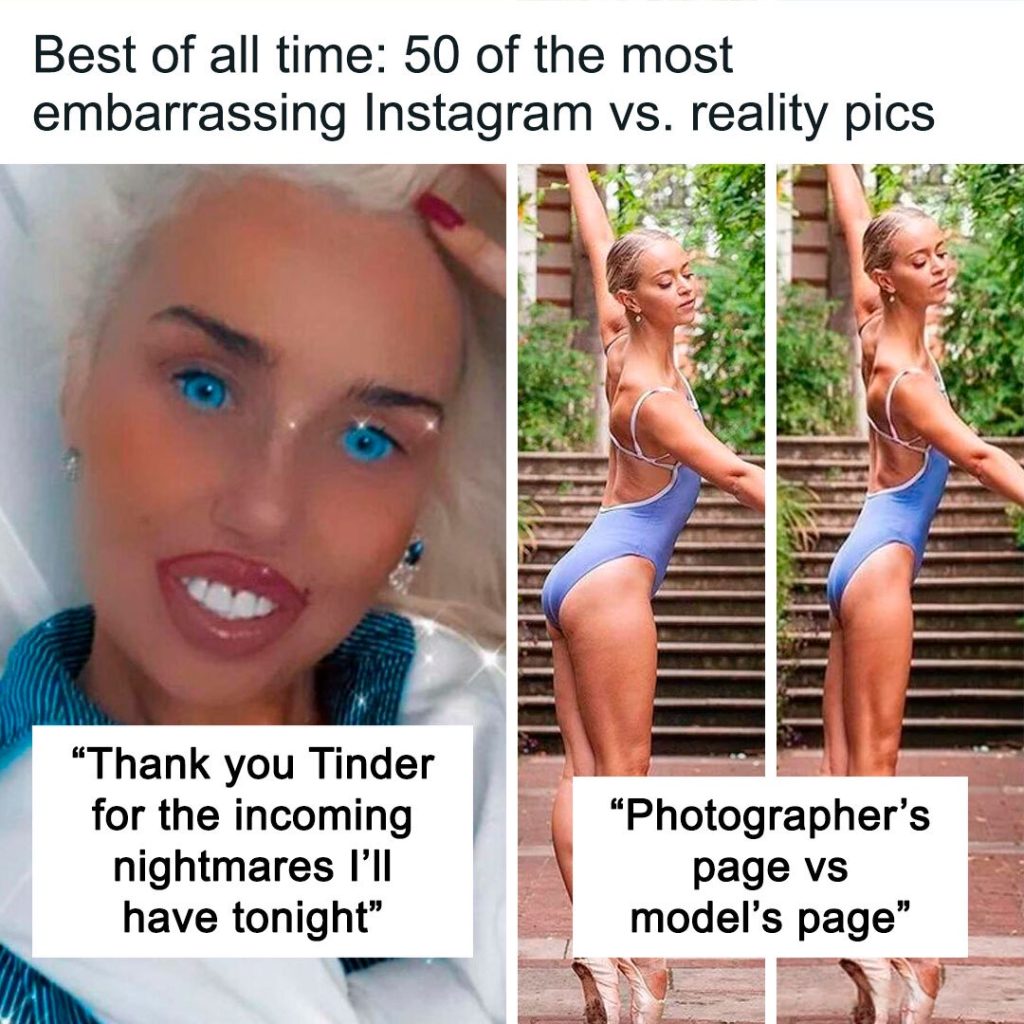Some photos people post online can range from adorable to downright offensive to the art of photography. But there’s a particularly fascinating genre of images that takes things to an entirely new level—photos so heavily filtered, it’s almost as if the person behind them believed no one would notice. Whether it’s skin smoothed beyond recognition, jaws contoured like comic book characters, or eyes edited to look like glass marbles, there’s no shortage of visual chaos when it comes to the “Instagram vs. reality” phenomenon.

The internet, of course, is never short on receipts. We’ve pulled together some of the most hilariously extreme examples of photo editing gone rogue, where filters and apps have been used with reckless abandon. These are the kinds of photos that spark everything from laughter to secondhand embarrassment—and sometimes even genuine concern. And while it’s easy to poke fun at the absurdity, there’s also something deeper to consider: Why are so many people driven to present such a distorted version of themselves?
To better understand the roots of this obsession with digital perfection, we reached out to Dr. Erin Vogel, a behavioral scientist and Assistant Professor at the University of Oklahoma Health Sciences Center. She provided some much-needed insight into the societal pressures that influence how people view themselves—and why many feel the need to alter their appearance so dramatically online.
“Beauty standards are rooted in systems of power,” Dr. Vogel explained. “People with privilege often set the benchmarks for what is considered beautiful. These standards are frequently unrealistic, and in many cases, not even healthy or desirable for most individuals. In the United States, for example, many dominant beauty ideals are shaped around Eurocentric features—fair skin, narrow noses, slim figures—and these ideals don’t reflect the diversity of our population.”
It’s not just social media users who perpetuate this trend. Traditional advertising and media have long promoted a narrow idea of beauty that excludes the vast majority of real people. These messages are repeated so often—in commercials, fashion magazines, TV shows, and online platforms—that we start to internalize them. Subtly but powerfully, they convince us that we need to buy products and services to fix what’s “wrong” with us. And when you feel like your natural self isn’t good enough, you’re more likely to shell out money to try and meet those impossible standards.
On platforms like Instagram, where curated images dominate and filters are just a tap away, the temptation to retouch becomes second nature for many users. A photo isn’t just a snapshot anymore—it becomes a personal brand statement, an audition for validation. And once someone starts tweaking one image, it’s a slippery slope. Before you know it, that little nip here or tuck there turns into a full-blown reinvention. The results are often shocking—and sometimes unintentionally hilarious.
Take, for example, a widely shared dating app profile where the person’s face looked more like a horror movie mask than a real human being. “Thank you, Tinder, for the nightmares I’m going to have tonight,” one viewer joked, summing up the general sentiment. In another viral image, a man posing confidently in a gym flexed with exaggerated muscle edits—but eagle-eyed viewers pointed out he was lifting only 25 pounds. “That’s not healthy, dude. Also, calm down,” one comment read.
Sometimes, the giveaways are subtle but unmistakable: a warped car door, a missing reflection, or an overly sharp jawline that looks like it was cut with Photoshop’s knife tool. One woman posted a highly edited selfie swearing she didn’t use any filters—yet commenters couldn’t help but notice that her features seemed so altered she looked like a plastic doll. “What happens when you pull the string in her back—does she say, ‘I swear I didn’t edit this’?” one user quipped.
There’s also the infamous “reflection fail,” where someone edited their face to look unrecognizably flawless but forgot to alter the version seen in the rearview mirror or window beside them. The contrast between the edited face and the untouched reflection is often enough to leave viewers in stitches. “Note to self: don’t forget to edit the reflection too,” one commenter remarked.
But these moments, while humorous on the surface, point to a larger issue—the lengths people will go to feel attractive and accepted in a digital world. The psychological effects can be profound. When someone constantly sees “perfect” images online, they may begin to see their real selves as inadequate. That insecurity feeds into more photo manipulation, and the cycle continues.
Dr. Vogel emphasized that breaking free from this toxic loop begins with awareness. “We need to challenge these beauty standards by embracing diversity in appearance and promoting realistic portrayals of people,” she said. “Social media can be a powerful tool for good when it’s used to show authenticity, vulnerability, and individuality—not just perfection.”
As you scroll through your feed, it’s worth remembering that behind every flawless face is a person with real insecurities, just like the rest of us. And sometimes, the best thing we can do—for our own mental health and for others—is to celebrate what makes us different, not what makes us look the same.
So, the next time you come across one of those overly filtered photos, take a moment to laugh if you must—but also reflect on what might have driven someone to post it. In a world full of filters, maybe the most radical act is to show up exactly as you are.





